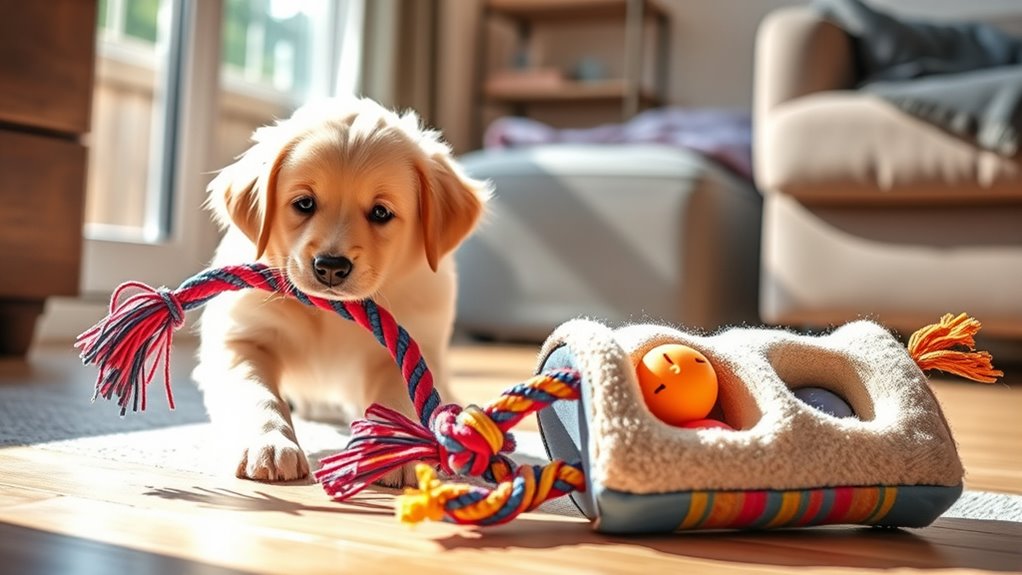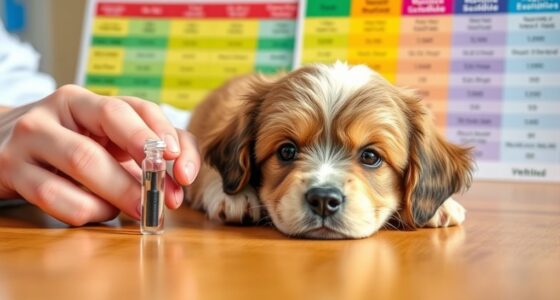To keep your puppy engaged, create DIY toys and sensory games using household items. Hide treats in textured boxes, use empty bottles or socks stuffed with paper for chews, and braid old t-shirts for tug toys. Rotate these activities to prevent boredom and stimulate your puppy’s senses. These simple ideas promote mental and physical growth while being budget-friendly. Keep exploring for more creative ways to enrich your puppy’s environment and encourage healthy development.
Key Takeaways
- Create sensory toys using household items like textured boxes, crumpled paper, and fabric to stimulate your puppy’s senses.
- Use simple puzzle games such as hiding treats in muffin tins or cardboard boxes to challenge problem-solving skills.
- Incorporate household objects like plastic bottles, socks, or old t-shirts into interactive play while supervising for safety.
- Rotate toys regularly to prevent boredom and promote engagement through new and varied activities.
- Design DIY enrichment activities that encourage natural behaviors, boost confidence, and provide mental and physical stimulation.

Ever wondered how to keep your puppy entertained without breaking the bank? The key lies in creating engaging, homemade toys that stimulate their mind and body. Puppy sensory play is a fantastic way to do this. It involves activities that activate your puppy’s senses—smell, touch, sight, and sound—helping them explore their environment while staying mentally stimulated. You can make simple sensory games at home using everyday items. For example, hide treats in different textured boxes or under crumpled paper to encourage your puppy to sniff and dig. These activities not only keep them busy but also boost their confidence and curiosity.
Homemade puzzle games are another effective method to challenge your puppy’s mind and prevent boredom. These puzzles can be as simple as hiding treats inside a muffin tin and covering the openings with tennis balls. Your puppy will have to figure out how to remove the balls to access the treats, engaging their problem-solving skills. You can also craft puzzle toys by threading treats through a piece of fabric or hiding them inside a cardboard box with holes. The goal is to create a fun challenge that encourages your pup to think and work for their rewards. These homemade puzzle games are cost-effective, easy to customize, and can be adapted to your puppy’s skill level as they grow.
In addition to sensory play and puzzle games, you can utilize common household items to craft toys that keep your puppy entertained. For example, an empty plastic bottle with some treats inside can become a noisy, engaging toy. Just make sure to supervise your puppy to prevent any choking hazards or ingestion of small parts. You can also braid old t-shirts into a tug toy or fill a sock with crumpled paper for a chewable distraction. The key is to keep things safe and stimulating, encouraging your puppy to explore and learn.
Incorporating DIY enrichment activities that are safe and engaging can also promote healthy development and reduce destructive behaviors. The goal is to keep your puppy’s mind active and their senses engaged, which is essential for their overall well-being. Regularly rotating these toys and games prevents boredom and keeps your puppy excited for new adventures. Remember, the goal is to stimulate their senses, challenge their minds, and provide safe outlets for natural behaviors—all without spending a lot of money. With a little imagination and some household items, you can turn everyday objects into enriching playthings that support your puppy’s development and happiness.
Frequently Asked Questions
What Safe Materials Should I Avoid When Making DIY Puppy Toys?
You should avoid using materials with toxic substances and sharp objects when making DIY puppy toys. Toxic substances can harm your puppy if ingested or chewed, so steer clear of paints, glues, or plastics with harmful chemicals. Sharp objects pose a risk of cuts or injuries, so never use broken or jagged items. Instead, opt for safe, non-toxic, and sturdy materials like cotton, rubber, or soft fabric to keep your pup safe and happy.
How Often Should I Rotate Homemade Toys for My Puppy?
You’re better off not putting all your eggs in one basket, so toy rotation is key. Swap out your puppy’s homemade toys every one to two weeks to keep their interest high and prevent boredom. Incorporate enrichment scheduling by introducing new toys gradually while retiring older ones. This way, your pup stays mentally stimulated and engaged, and you can monitor which toys they love best for future DIY projects.
Can DIY Toys Help With Separation Anxiety in Puppies?
Yes, DIY toys can help with separation anxiety in puppies by providing stress relief and reducing boredom. When you create engaging, homemade toys, your pup stays occupied and calm when alone. These toys offer comfort, stimulation, and a distraction from anxious feelings. Consistently rotating and offering new DIY toys keeps your puppy interested, helping ease separation anxiety and promoting a sense of security even when you’re not around.
What Age Is Appropriate for Introducing DIY Toys to Puppies?
You can introduce DIY toys to your puppy early, around 8 weeks old, once they’ve started exploring and have their first vaccinations. Always prioritize toy safety by avoiding small parts they could swallow and choosing non-toxic materials. Keep a close eye on your pup during playtime, and supervise their interaction with homemade toys. Early introduction helps with mental stimulation and bonding, making sure your puppy stays engaged and happy as they grow.
How Do I Ensure DIY Toys Are Hygienic and Easy to Clean?
Did you know that puppies can carry bacteria on their toys? To keep DIY toys hygienic, establish regular cleaning routines using safe, non-toxic cleaners. Choose durable materials like rubber or sturdy fabric that withstand frequent washing. Avoid porous or absorbent materials that trap dirt. By cleaning your puppy’s DIY toys consistently and selecting durable materials, you guarantee they stay safe, easy to clean, and long-lasting for your puppy’s playtime.
Conclusion
Think of your puppy’s mind as a garden, bursting with potential. With your creative DIY toys and enrichment games, you’re like a caring gardener, planting seeds of curiosity and joy. As you nurture these playful moments, watch your puppy blossom into a confident, happy companion. Keep tending to their mental and physical needs, and together you’ll cultivate a bond that grows stronger each day—an endless, joyful adventure in the garden of your shared life.










